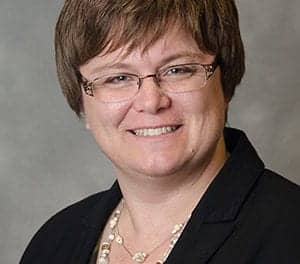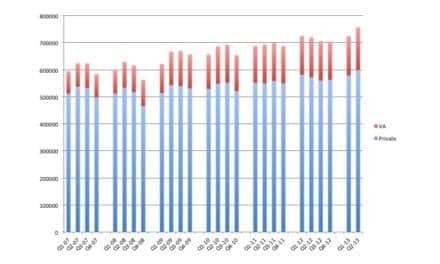
As the Information Age unfolds, people with hearing loss are increasingly drawn to new technologies that enable them to keep pace with the connected world they have already become accustomed to. They are no longer content with mere hearing instruments; they want to know how they can benefit from the latest technologies—and they are looking to hearing care professionals for answers.
For example in 1996, a California Bay Area attorney who has a profound hearing loss went searching for a wireless communication service that could accommodate her hearing needs. She maintains an active, mobile lifestyle, and she found that her options relative to personal communication devices were extremely limited. Only a few wireless companies were trying to serve the deaf community (mostly as a sideline market) in 1996, and their services did not include key technology, such as mobile TTY/TTD devices.
A New Generation of Clients
In response to these types of needs, technology developers have been inspired to create services that are opening new options for hearing-impaired individuals. People like the above attorney represent a new kind of hearing-impaired client; these consumers are more active and more technologically savvy than the traditional hearing instrument user. They have experienced the larger part of their working career in the world of ATMs, computers, and wireless communication. Tinkering with VCRs, cell phones, and computers is second-nature to this crowd. And, for both safety and convenience, they demand the ability to accurately communicate with the office, their family, and their friends.
This new generation of clients often do not have the time—or the patience—for digital phones that cause interference with hearing instruments. This is where a text-based communications service, available through a wireless palm-sized pager, provides a combination of convenience and communication clarity.
A New Generation of Communication Facilitators
When deaf and hearing-impaired clients are given the option to have exact and clear communication in any environment, it allows them to shrug off limitations and to embrace an active lifestyle. It is also a chance for hearing health care providers to treat individual needs and to establish themselves as communications facilitators, rather than simply dispensing hearing instruments.
Two-way pagers now have features tailored for people with hearing loss, making them an excellent complement to hearing instruments. Service providers can provide clients access to e-mail, the Web, and more. For example, the WyndTell Service offers a suite of two-way features, including text-to-voice messaging, faxing, and robust TTY communication (Figure 1).
Two-Way Communication Services
Voice options in the world of wireless technology continue to be refined, but the jury is still out on their inherent value to the person with hearing loss. Analog cellular, which provides interference-free listening for hearing instrument wearers, is quickly becoming obsolete. Equally frustrating for the user, the digital phones that are replacing the analog phones are notorious for the interference they cause as information is transmitted from the phone’s antenna. Known as pulsing, this phenomenon interferes with many hearing instruments. Additionally, talking on a phone in a noisy environment can be extremely challenging for both hearing-impaired and normal-hearing users.
The limitations inherent to voice technology underscore the value of text-based communication for people with hearing loss. Typing and reading is a desirable alternative. Regardless of environment, text delivers flexibility and freedom. In a wireless, mobile format, it can be an extremely convenient option.
The Convergence of Text and Speech Technologies
The distinction between text and voice solutions is blurring, with voice phones delivering some text messaging, and text devices integrating voice functionality. Some might call this confusing, but the blending actually provides more features and, ultimately, more flexibility for the user. For example, WyndTell users can send messages to another pager, to a computer, fax machine, TTY, or send and receive voice messages. Conversely, many phones have enabled short messaging, allowing email-like messages to be typed out on the phone’s keypad and transmitted to other phone users.
Further blurring the traditional lines of communication, other technologies on the horizon combine traditional wireless tools with videoconferencing and more. These new technologies offer great potential, but are still unproven, impractical for the typical user, and, as a result, a long way off for hearing-impaired clients. Pagers, on the other hand, are a proven and reliable technology. Initially exclusive to physicians and other professionals, pagers are now firmly embedded in the mainstream and employed for social and professional communication across the entire spectrum of age groups.
It is no secret why this wireless technology endures today, particularly with the value-added services that have become integral to owning a pager. Modern pagers equipped with special services are multidimensional two-way devices that engage everything from faxes to email, and TTY to telephone calls.
These added dimensions are due in large part to the fact that these devices are not cellular, but instead rely on “packetized” data traveling on a radio frequency. Offering the most complete array of communication services, this packet technology is designed to combine the go-anywhere convenience of cellular with the flexibility of being able to communicate the way you desire. Also a cost-effective alternative to cellular, pagers offer 24-hour access without the expensive burdens of roaming, long distance, and time-restriction fees. And, unlike cell phones, they remain discreet yet enable the user to communicate clearly in noisy environments, such as restaurants, motor vehicles, or events.
By offering wireless pager technology, hearing care professionals can empower their clients with a total communications solution while ensuring maximum product satisfaction for hearing instruments. This cultivates confidence, trust, and loyalty—the mortar for a successful practice that is easily differentiated from the competition.
MPC Profile Questionnaire
A newly developed MPC questionnaire (see sidebar, page 46) is designed to make it easier for hearing care professionals to determine which clients are the right candidates for a text-based communications service. Similar to tests that point out a client’s need for a particular hearing instrument, this interview tool acts as an easy-to-use litmus test, revealing who may or may not benefit from wireless service.
Each multiple choice answer corresponding to the different questions is assigned a point value (ie, the score shown in superscript at the end of the response). Lower numbers are associated to attributes showing the client to be less likely to embrace or benefit from wireless technology, while higher numbers point out characteristics typical of a client that would benefit from it. A client’s total MCP score correlates to their level of “wireless need,” thus guiding the hearing care professional in recommending the best technology tools and format for the patient. The MCP questionnaire is designed both as a formal test and also as a guide for hearing care professionals during the counseling process.
Summary
With the wide range of communication tools now available, clients and hearing care professionals are charting new ground in the quest for “total communications.” Wireless communication services are enabling deaf and hard-of-hearing individuals to embrace their independence in ways not thought possible just a few years ago—and they’re looking for hearing care professionals to introduce them to the technology that makes this independence a reality in everyday life.
|
The Mobile Communication Profile The mobile communication profile is designed as a test for hearing care professionals to administer to clients who are candidates for wireless communication. The following questions are designed to provide a gauge of patients’ needs for wireless technology in general. 1. How often do you travel away from home or the office? 2. How much time, on average, do you spend in the car 3a. Do you currently use a cellular phone? 3b. If yes, how often do you experience interference? 3c. If yes, how often is it difficult to hear on the cell phone? 3d. If yes, what are the primary reasons you have a cell phone (check all that apply)? 4. If your hearing instrument has a telecoil, does it enhance or interfere with your cellular phone? 5a. Do you use email? 5b. If yes, how often do you go online to check your email? 5c. If yes, with whom do you regularly communicate via email? (check all that apply) 6. What is your level of hearing loss? 7. How would you describe your comfort level with technology? 8. Not including you, how many people in your household have some level of hearing loss?
|
This article was submitted by Malei Jessee Weir, a communications professional from Los Alamos, Calif, who writes on topics related to wireless communications. Correspondence can be addressed to HR or Malei Jessee Weir, c/o Joseph Karp, Wynd Communications, 75 Higuera St., Ste 240, San Luis Obispo, CA 93401; email: [email protected].





